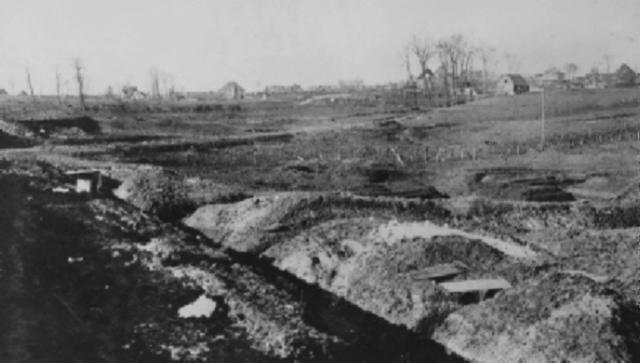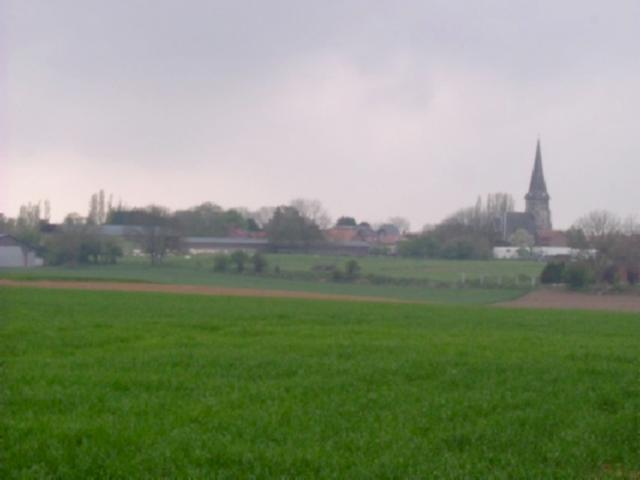Topic: BatzWF - Westn Front
First Bullecourt
France, 11 April 1917

First Bullecourt, the battle on 11 April 1917 to capture a strongpoint in the string of defences across northern France which the Germans called the Siegfried Line but which were known to the Allies as the Hindenburg Line. Following their heavy losses in the Somme campaign during 1916, the next March the Germans made a deliberate withdrawal into a shorter line fifteen to 50 kilometres to their rear. In response to discovery of this move, the two Australian divisions of I Anzac Corps then in the line around Hers (2nd and 5th) were ordered to send out columns to follow up the enemy retirement in conjunction with British formations on both flanks.

After a period of comparatively rapid advance, during late March and early April these operations became more intense as the Australians found themselves up against strong rearguard forces which the Germans had left behind in outpost villages to impose delay. Several resulting actions were fiercely fought encounters entailing moderately heavy casualties-377 at Lagnicourt on 26 - 27 March; more than 600 at Noreuil on 2 April; and 649 at Hermies, Boursies and Demicourt on 8 - 9 April. The last-mentioned series of actions coincided with the stroke undertaken at Arras by the British Third Army at the start of a new great offensive. It was to assist this operation that the Fifth Army (which included 1 Anzac Corps) was tasked with attacking the Hindenburg Line south of Arras. The point selected for attack was Bullecourt, which-now heavily fortified - had been incorporated into the German defences as an advanced bastion.
Carriage of the attack was entrusted to two brigades (4th and 12th) of the 4th Australian Division which were marched up in extreme haste. These were to strike east of the village and then swing left and advance along the trench system from the flank. Upon their success, the British 62nd Division on the Australian left would also move forward to capture the village itself and link up for a push through into the rear of the German defences. A surprise element would be a dozen British tanks leading the assault - the first time these machines had been used in the Fifth Army-and their task was to break down the enemy's formidable wire entanglements for the following infantry.

During the attack launched at 4.30 a.m. on 11 April both brigades succeeded in penetrating the front line of trenches and seizing part of the second line, but without the benefit of any support from the tanks which by 7 a.m. were all burning wrecks littering the battlefield: only four even reached the enemy wire, and just one got to the first trench-line. The troops had achieved almost the impossible in advancing without a protective artillery barrage or the gunfire support which the tanks had been meant to provide.
While the Australians had got inside the Hindenburg Line, they now found themselves fighting without support and cut off from reinforcements. In the mistaken belief that attack parties had passed deep into enemy rear positions, Allied artillery was prohibited from firing - thereby giving the Germans a free hand in dealing with the penetration. In addition, the enemy resistance encountered grew steadily as members of the 27th Württemberg Division emerged from deep shelters on the flanks and even in rear of the assault waves. Half, an hour after midday the survivors began limping back away from their untenable gain. Barely 660 men out of 3,000 members of the 4th Brigade remained alive or uninjured, and the 12th Brigade had suffered 950 casualties; 1,170 of the attackers had passed into enemy hands as prisoners - the largest number of Australians captured in a single battle. The adverse impression about the utility of tanks would remain with Australians for more than a year.

Extracted from the book produced by Chris Coulthard-Clark, Where Australians Fought - The Encyclopaedia of Australia's Battles, Allen and Unwin, Sydney, 1998, pp. 125-126.
Additional References cited by Chris Coulthard-Clark:
C.E.W. Bean, (1933), The Australian Imperial Force in France 1917, Sydney: Angus & Robertson.
Further Reading:
Battles where Australians fought, 1899-1920
Citation: First Bullecourt, France, April 11, 1917



